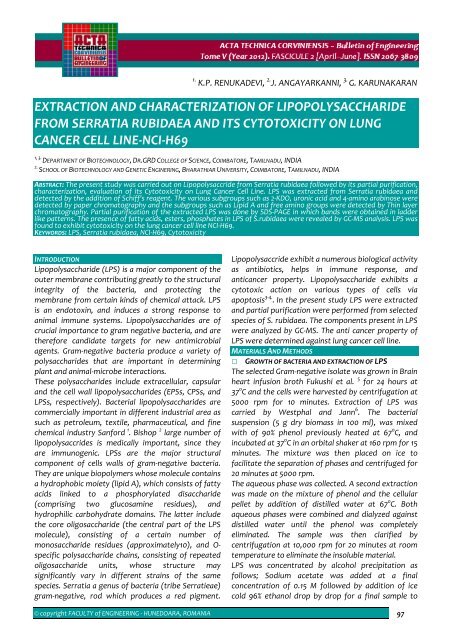Editorial & Advisory Board - Acta Technica Corviniensis
Editorial & Advisory Board - Acta Technica Corviniensis
Editorial & Advisory Board - Acta Technica Corviniensis
Create successful ePaper yourself
Turn your PDF publications into a flip-book with our unique Google optimized e-Paper software.
1. K.P. RENUKADEVI, 2. J. ANGAYARKANNI, 3. G. KARUNAKARAN<br />
EXTRACTION AND CHARACTERIZATION OF LIPOPOLYSACCHARIDE<br />
FROM SERRATIA RUBIDAEA AND ITS CYTOTOXICITY ON LUNG<br />
CANCER CELL LINE‐NCI‐H69<br />
1, 3.<br />
DEPARTMENT OF BIOTECHNOLOGY, DR.GRD COLLEGE OF SCIENCE, COIMBATORE, TAMILNADU, INDIA<br />
2.<br />
SCHOOL OF BIOTECHNOLOGY AND GENETIC ENGINERING, BHARATHIAR UNIVERSITY, COIMBATORE, TAMILNADU, INDIA<br />
ABSTRACT: The present study was carried out on Lipopolysaccride from Serratia rubidaea followed by its partial purification,<br />
characterization, evaluation of its Cytotoxicity on Lung Cancer Cell Line. LPS was extracted from Serratia rubidaea and<br />
detected by the addition of Schiff’s reagent. The various subgroups such as 2‐KDO, uronic acid and 4‐amino arabinose were<br />
detected by paper chromatography and the subgroups such as Lipid A and free amino groups were detected by Thin layer<br />
chromatography. Partial purification of the extracted LPS was done by SDS‐PAGE in which bands were obtained in ladder<br />
like patterns. The presence of fatty acids, esters, phosphates in LPS of S.rubidaea were revealed by GC‐MS analysis. LPS was<br />
found to exhibit cytotoxicity on the lung cancer cell line NCI‐H69.<br />
KEYWORDS: LPS, Serratia rubidaea, NCI‐H69, Cytotoxicity<br />
INTRODUCTION<br />
Lipopolysaccharide (LPS) is a major component of the<br />
outer membrane contributing greatly to the structural<br />
integrity of the bacteria, and protecting the<br />
membrane from certain kinds of chemical attack. LPS<br />
is an endotoxin, and induces a strong response to<br />
animal immune systems. Lipopolysaccharides are of<br />
crucial importance to gram negative bacteria, and are<br />
therefore candidate targets for new antimicrobial<br />
agents. Gram‐negative bacteria produce a variety of<br />
polysaccharides that are important in determining<br />
plant and animal‐microbe interactions.<br />
These polysaccharides include extracellular, capsular<br />
and the cell wall lipopolysaccharides (EPSs, CPSs, and<br />
LPSs, respectively). Bacterial lipopolysaccharides are<br />
commercially important in different industrial area as<br />
such as petroleum, textile, pharmaceutical, and fine<br />
chemical industry Sanford 1 . Bishop 2 large number of<br />
lipopolysaccrides is medically important, since they<br />
are immunogenic. LPSs are the major structural<br />
component of cells walls of gram‐negative bacteria.<br />
They are unique biopolymers whose molecule contains<br />
a hydrophobic moiety (lipid A), which consists of fatty<br />
acids linked to a phosphorylated disaccharide<br />
(comprising two glucosamine residues), and<br />
hydrophilic carbohydrate domains. The latter include<br />
the core oligosaccharide (the central part of the LPS<br />
molecule), consisting of a certain number of<br />
monosaccharide residues (approximately10), and O‐<br />
specific polysaccharide chains, consisting of repeated<br />
oligosaccharide units, whose structure may<br />
significantly vary in different strains of the same<br />
species. Serratia a genus of bacteria (tribe Serratieae)<br />
gram‐negative, rod which produces a red pigment.<br />
Lipopolysaccride exhibit a numerous biological activity<br />
as antibiotics, helps in immune response, and<br />
anticancer property. Lipopolysaccharide exhibits a<br />
cytotoxic action on various types of cells via<br />
apoptosis 3‐4. . In the present study LPS were extracted<br />
and partial purification were performed from selected<br />
species of S. rubidaea. The components present in LPS<br />
were analyzed by GC‐MS. The anti cancer property of<br />
LPS were determined against lung cancer cell line.<br />
MATERIALS AND METHODS<br />
GROWTH OF BACTERIA AND EXTRACTION OF LPS<br />
The selected Gram‐negative isolate was grown in Brain<br />
heart infusion broth Fukushi et al. 5 for 24 hours at<br />
37 o C and the cells were harvested by centrifugation at<br />
5000 rpm for 10 minutes. Extraction of LPS was<br />
carried by Westphal and Jann 6 . The bacterial<br />
suspension (5 g dry biomass in 100 ml), was mixed<br />
with of 90% phenol previously heated at 67 o C, and<br />
incubated at 37 o C in an orbital shaker at 160 rpm for 15<br />
minutes. The mixture was then placed on ice to<br />
facilitate the separation of phases and centrifuged for<br />
20 minutes at 5000 rpm.<br />
The aqueous phase was collected. A second extraction<br />
was made on the mixture of phenol and the cellular<br />
pellet by addition of distilled water at 67 o C. Both<br />
aqueous phases were combined and dialyzed against<br />
distilled water until the phenol was completely<br />
eliminated. The sample was then clarified by<br />
centrifugation at 10,000 rpm for 20 minutes at room<br />
temperature to eliminate the insoluble material.<br />
LPS was concentrated by alcohol precipitation as<br />
follows; Sodium acetate was added at a final<br />
concentration of 0.15 M followed by addition of ice<br />
cold 96% ethanol drop by drop for a final sample to<br />
© copyright FACULTY of ENGINEERING ‐ HUNEDOARA, ROMANIA 97

















